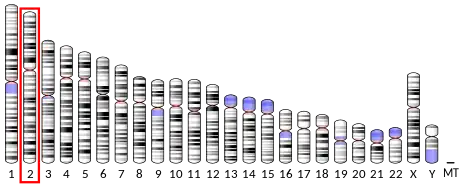ANKRD23
Ankyrin repeat domain-containing protein 23 is a protein that in humans is encoded by the ANKRD23 gene.[5][6]
| ANKRD23 | |||||||||||||||||||||||||||||||||||||||||||||||||||
|---|---|---|---|---|---|---|---|---|---|---|---|---|---|---|---|---|---|---|---|---|---|---|---|---|---|---|---|---|---|---|---|---|---|---|---|---|---|---|---|---|---|---|---|---|---|---|---|---|---|---|---|
| Identifiers | |||||||||||||||||||||||||||||||||||||||||||||||||||
| Aliases | ANKRD23, DARP, MARP3, ankyrin repeat domain 23 | ||||||||||||||||||||||||||||||||||||||||||||||||||
| External IDs | OMIM: 610736 MGI: 1925571 HomoloGene: 14025 GeneCards: ANKRD23 | ||||||||||||||||||||||||||||||||||||||||||||||||||
| |||||||||||||||||||||||||||||||||||||||||||||||||||
| |||||||||||||||||||||||||||||||||||||||||||||||||||
| |||||||||||||||||||||||||||||||||||||||||||||||||||
| |||||||||||||||||||||||||||||||||||||||||||||||||||
| |||||||||||||||||||||||||||||||||||||||||||||||||||
| Wikidata | |||||||||||||||||||||||||||||||||||||||||||||||||||
| |||||||||||||||||||||||||||||||||||||||||||||||||||
This gene is a member of the muscle ankyrin repeat protein (MARP) family and encodes a protein with four tandem ankyrin-like repeats. The protein is localized to the nucleus, functioning as a transcriptional regulator. Expression of this protein is induced during recovery following starvation.[6]
References
- GRCh38: Ensembl release 89: ENSG00000163126 - Ensembl, May 2017
- GRCm38: Ensembl release 89: ENSMUSG00000067653 - Ensembl, May 2017
- "Human PubMed Reference:". National Center for Biotechnology Information, U.S. National Library of Medicine.
- "Mouse PubMed Reference:". National Center for Biotechnology Information, U.S. National Library of Medicine.
- Ikeda K, Emoto N, Matsuo M, Yokoyama M (Feb 2003). "Molecular identification and characterization of a novel nuclear protein whose expression is up-regulated in insulin-resistant animals". J Biol Chem. 278 (6): 3514–20. doi:10.1074/jbc.M204563200. PMID 12456686.
- "Entrez Gene: ANKRD23 ankyrin repeat domain 23".
- Miller, Melanie K; Bang Marie-Louise; Witt Christian C; Labeit Dietmar; Trombitas Charles; Watanabe Kaori; Granzier Henk; McElhinny Abigail S; Gregorio Carol C; Labeit Siegfried (Nov 2003). "The muscle ankyrin repeat proteins: CARP, ankrd2/Arpp and DARP as a family of titin filament-based stress response molecules". J. Mol. Biol. 333 (5): 951–64. doi:10.1016/j.jmb.2003.09.012. ISSN 0022-2836. PMID 14583192.
External links
- Human ANKRD23 genome location and ANKRD23 gene details page in the UCSC Genome Browser.
Further reading
- Hillier LW; Graves TA; Fulton RS; et al. (2005), "Generation and annotation of the DNA sequences of human chromosomes 2 and 4", Nature, 434 (7034): 724–31, Bibcode:2005Natur.434..724H, doi:10.1038/nature03466, PMID 15815621
- Gerhard DS; Wagner L; Feingold EA; et al. (2004), "The status, quality, and expansion of the NIH full-length cDNA project: the Mammalian Gene Collection (MGC)", Genome Res., 14 (10B): 2121–7, doi:10.1101/gr.2596504, PMC 528928, PMID 15489334
- Nagueh SF; Shah G; Wu Y; et al. (2005), "Altered titin expression, myocardial stiffness, and left ventricular function in patients with dilated cardiomyopathy", Circulation, 110 (2): 155–62, doi:10.1161/01.CIR.0000135591.37759.AF, PMID 15238456
- Ota T; Suzuki Y; Nishikawa T; et al. (2004), "Complete sequencing and characterization of 21,243 full-length human cDNAs", Nat. Genet., 36 (1): 40–5, doi:10.1038/ng1285, PMID 14702039
- Miller MK; Bang ML; Witt CC; et al. (2003), "The muscle ankyrin repeat proteins: CARP, ankrd2/Arpp and DARP as a family of titin filament-based stress response molecules", J. Mol. Biol., 333 (5): 951–64, doi:10.1016/j.jmb.2003.09.012, PMID 14583192
- Strausberg RL; Feingold EA; Grouse LH; et al. (2003), "Generation and initial analysis of more than 15,000 full-length human and mouse cDNA sequences", Proc. Natl. Acad. Sci. U.S.A., 99 (26): 16899–903, Bibcode:2002PNAS...9916899M, doi:10.1073/pnas.242603899, PMC 139241, PMID 12477932
- Dias Neto E; Correa RG; Verjovski-Almeida S; et al. (2000), "Shotgun sequencing of the human transcriptome with ORF expressed sequence tags", Proc. Natl. Acad. Sci. U.S.A., 97 (7): 3491–6, Bibcode:2000PNAS...97.3491D, doi:10.1073/pnas.97.7.3491, PMC 16267, PMID 10737800
This article is issued from Wikipedia. The text is licensed under Creative Commons - Attribution - Sharealike. Additional terms may apply for the media files.



